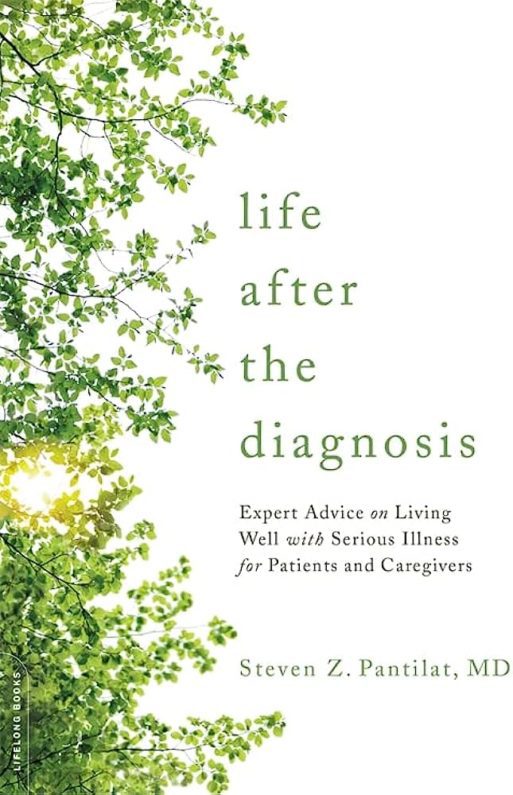 Dr. Steven Pantilat’s “Life After the Diagnosis: Expert Advice on Living Well with Serious Illness for Patients and Caregivers” is a wonderful resource for individuals and families struggling to cope with life-limiting illness. Written in easy-to-understand layman’s terms, the book guides the reader through the complex, difficult journey of “being sick”– from the moment one hears “the news” to the inevitable end of life.
Dr. Steven Pantilat’s “Life After the Diagnosis: Expert Advice on Living Well with Serious Illness for Patients and Caregivers” is a wonderful resource for individuals and families struggling to cope with life-limiting illness. Written in easy-to-understand layman’s terms, the book guides the reader through the complex, difficult journey of “being sick”– from the moment one hears “the news” to the inevitable end of life.
The book begins with a straightforward examination of what it’s like to hear distressing news. It talks about grief and denial and the fact that most people will feel paralyzed by uncertainty when they learn that they are seriously ill. It’s a tribute to Dr. Pantilat’s years as a palliative care physician that he acknowledges this, and encourages patients to take the time to process their feelings before taking any action. Most of us believe that a serious diagnosis means we have to make decisions immediately. But that’s rarely the case.
In each chapter of “Life After the Diagnosis,” Dr. Pantilat tackles a different aspect of serious illness in the same straightforward, no-nonsense way. He talks about medical jargon and the confusion it causes when doctors use terms that have different meanings in the “real” world. “Progress,” for example, has a positive connotation in most contexts. But when a doctor says a tumor is “progressing” that is definitely not good news. Similarly, many doctors will ask seriously ill patients, “Would you like us to do everything possible?” without explaining that “everything possible” could mean painful, debilitating treatments that will simply prolong their death.
Throughout “Life After the Diagnosis,” Dr. Pantilat uses examples from his own practice to illustrate various points, such as symptom management and pain control. These real-world examples provide us with some much needed context and add a degree of humanity and warmth to a book that occasionally feels almost too matter-of-fact.
Prognosis and Hope

Credit: stevepantilat.com
Although each chapter in “Life After the Diagnosis” covers a different aspect of serious illness, the overarching message is that every illness follows its own trajectory, and that patients and their families will have to adapt again and again. For example, a tumor that responded well to surgery and radiation therapy may eventually come back. A person with dementia may be doing well at home and then suddenly develop pneumonia and require ICU care. Or a person whose heart failure seemed well-controlled on medication may have a sudden, massive heart attack. And at each of these junctures, the patient and/or their family will be asked to make difficult decisions about what to do next.
Dr. Pantilat does an excellent job of addressing these types of scenarios. He writes about prognosis, and how important it is for both patients and their doctors to be realistic about what to expect. He also writes about the fact that doctors sometimes withhold the truth because they believe that the patient will “lose hope.” But then he explains that this thinking is both unhelpful and illogical because hope can and does evolve. Even a person who knows they are dying can hope for many things: for example, a pain-free death, a chance to tell their loved ones goodbye, or to see the sunset one last time.
The Goals of Care
But Dr. Pantilat’s strongest message is about the need to constantly evaluate the goals of care. In the beginning, he explains, it’s very often realistic to hope for long-term survival and to set goals that are consistent with that. But as time goes on and an illness progresses, it can be unhelpful and even dangerous to continue to try to achieve those goals. Patients are harmed every day because well-meaning doctors offer futile treatments that do nothing to improve the person’s quality of life. And patients and their families often agree to these treatments because they simply don’t understand the risks and benefits involved.

Seriously ill patients face many difficult decisions
Credit: todayshospitalist.com
If you have been diagnosed with a life-limiting illness or know someone who has, please read “Life After the Diagnosis.” It’s perhaps a little too clinical in places. But it is an invaluable resource for those who are trying to forge a path to their best possible life regardless of the hand they’ve been dealt.
Did you enjoy this post? Read our interview with Dr. Pantilat to learn more about coping with serious illness.

 “Life After the Diagnosis” by Dr. Steven Z. Pantilat
“Life After the Diagnosis” by Dr. Steven Z. Pantilat


 “As Tears Go By” by Marianne Faithfull
“As Tears Go By” by Marianne Faithfull

 Funeral Favors Offer Visitors a Tangible Memento
Funeral Favors Offer Visitors a Tangible Memento















